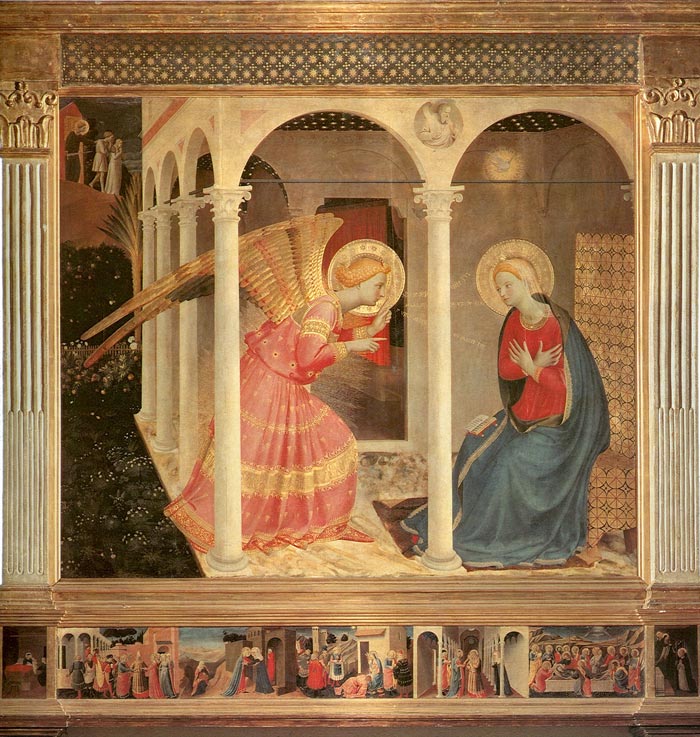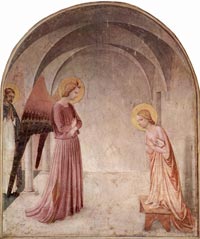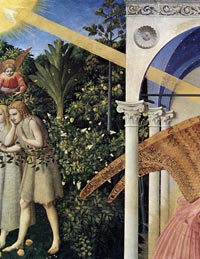| |
|
Predella
|
|
|
Marriage of the Virgin. |
|
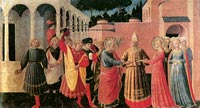 Marriage of the Virgin Marriage of the Virgin
|
| This picture shows the scene of the Visitation. The event shown here is described in the Gospel of Luke. Immediately following the Annunciation, Mary 'went into the hill country with haste, into a city of Juda; and entered into the house of Zacharias, and saluted Elisabeth' (Luke 1, v. 39-40). The Virgin and Elisabeth embrace, the straight folds of their gowns showing a simplicity and reserve alien to the curvilinear trecento influences of some ofAngelico's mentors and contemporaries. Elisabeth, six months pregnant with John the Baptist, is given a wider girth than her cousin. Juda is represented by a series of simple, geometric forms, sharply lit but slightly thin and awkward. A woman makes her way up the hill path which lies in shadow below her. Behind her the sky and earth meet in the haze of a Tuscan summer.
This is the first identifiable landscape in Italian art. In the middle distance a lake (Lake Trasimeno as seen from Cortona), spreads out in the Chiana Valley. Beyond rises the town of Castigliona Florentino, and further distant the tower of Monterchi. |
|
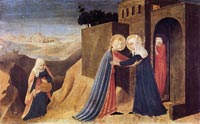
Visitation |
|
|
|
|
|
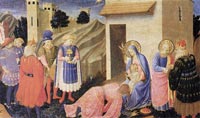
Adoration of the Magi
|
In the Presentation of Christ in the Temple, Joseph, the Virgin, the High Priest and St Anne stand in the foreground, a nave of receding columns extending backwards behind them. Exterior space is hinted at by the doorway to the left, the round window in the apse, the edge of the top light high above the nave and the strong light hitting the foreground from a source outside the picture space. |
|
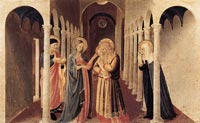
The Presentation of Christ in the Temple
|
| |
|
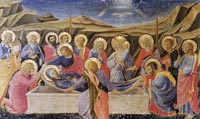
Death of the Virgin |
|
|
|
Fra Angelico, The Annunciation, c. 1430, Prado, Madrid
|
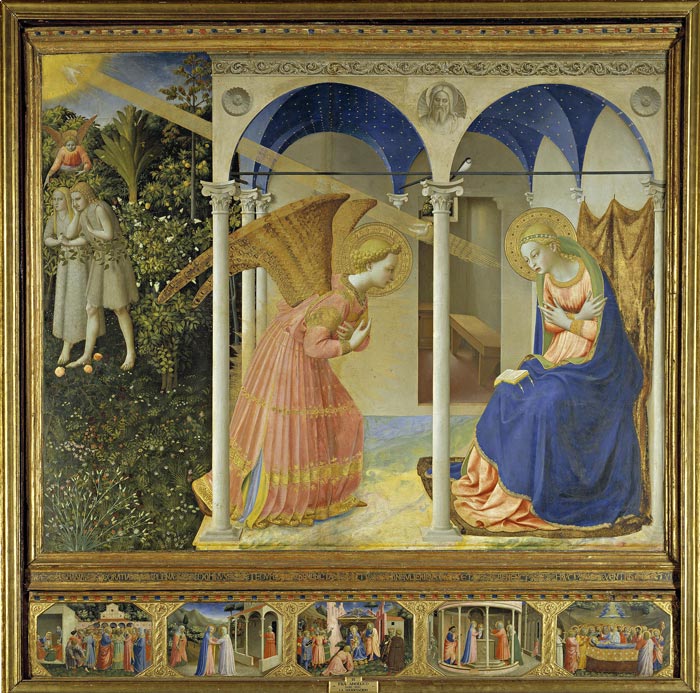 |
Fra Angelico, The Annunciation, c. 1430, Prado, Madrid
|
The Annunciation (154 x 194 cm) is the main painting on the altarpiece known as the Prado Altarpiece. The painting comes from the Church of San Domenico in Fiesole, it was sold and taken to Spain in 1611.
There are five small (23 x 35 cm each) predella pictures below the Annunciation, painted on the same panel, depicting the story of the Virgin.
Fra Angelico, also known as Blessed Angelico, dedicated his work exclusively to religious subjects as he understood art to be an aspect of religious devotion. He was particularly meticulous in the details and qualities of Nature and of the objects and persons depicted. In his style, Fra Angelico merged the late Gothic Italian style with the new language of the Renaissance. An example of this is the architecture’s spatial depth, which, while in keeping with Brunelleschi’s recommendation to occupy the center of a square and unadorned stage, nevertheless shows some of the errors present in Angelico’s early works.
The central panel shows the Archangel Gabriel’s Annunciation to Mary under a portico.
The five predella pictures, painted on the same panel, depict the story of the Virgin.On the left, Adam and Eve are being expelled from Paradise. The damnation and salvation of Humanity. The predella has scenes from the life of the Virgin; Mary’s Birth, Her Wedding with Saint Joseph, Mary’s Visit to her cousin Saint Elisabeth, the Birth of the Christ Child, the Presentation of Jesus in the Temple and the Dormition of the Virgin with Christ receiving her soul.
The altarpiece, and especially the predella paintings are of extremely high quality thus without any doubts they are the works of Fra Angelico. The design of the central image was reused by Fra Angelico in the Cortona Annunciation and in the fresco at the head of the staircase leading to the dormitory of his monastery, San Marco in Florence. The new Renaissance command of architectural perspective accompanies a continuing medieval delight in the lavish use of gilding.
On the extreme left of the Annunciation scene is a patch of vegetation, where in the distance Adam and Eve are being sent out of Paradise by the angel. The meaning is clear: the coming of Christ as promised by the Annunciation will redeem the sin of the first children. |
|
|
| |
|
|
|
|
|
Fra Angelico, The Annunciation (1), Convento di San Marco, Florence
|
Fra Angelico is best-known for his series of frescos concerning the Life and especially the Passion of Christ, which he painted at the convent of San Marco - mostly as an aid to contemplation in the friars' cells.
After he joined the Dominican Order, Fra Angelico initially worked on illustrating holy manuscripts and then progressed to painting triptychs for Church Altars and frescoes for the Church and the Monastery. The Fresco painting was usually undertaken with a large group of assistants, who worked under his strict supervision and direction. The frescoes at the Monastery of San Marco, showing scenes from the New Testament, were begun in 1441 and are considered to be some of his finest works – realistic and spiritual at the same time and with magnificent coloring. Fra Angelico's perfectly balanced and jewel-like color schemes remind me of the equally eye-catching color schemes utilized in Indian Miniatures.
|
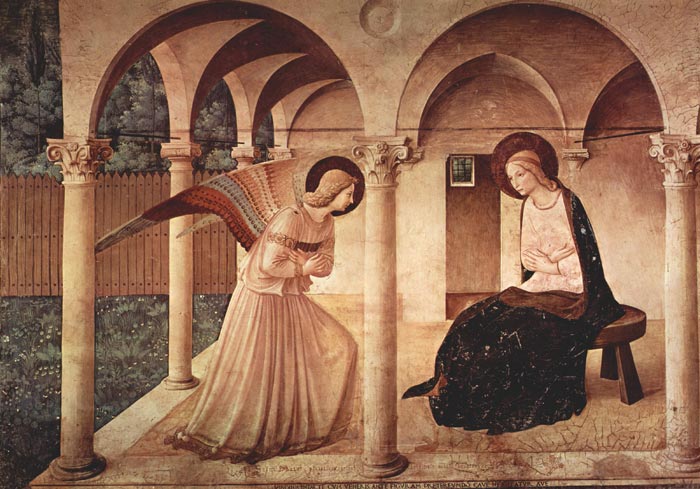 |
Fra Angelico, The Annunciation, late 1430's, Convento di San Marco, Florence
|
Facing the entrance of the upper corridor of the cloister he painted the Angel bringing the glad tidings to the Virgin. We have already noted in regard to this subject as created by him at Cortona, how the representation finds its greater development here, where the artist succeeds better in rendering the feeling of veneration on the part of the heavenly messenger, and the submissive humility of the Virgin.
In the background Fra Angelico painted typical Tuscan cypresses.
The purpose of the black lines between the arcs of the loggia is unclear. They do show that Angelico had good control of linear perspective.
The same subject is repeated in a cell (No. 3), but in this design, which breathes the same sentiment of sweetness and piety, St. Dominic in reverent attitude is looking on. |
Fra Angelico, The Annunciation (2), Convento di San Marco, Florence
|
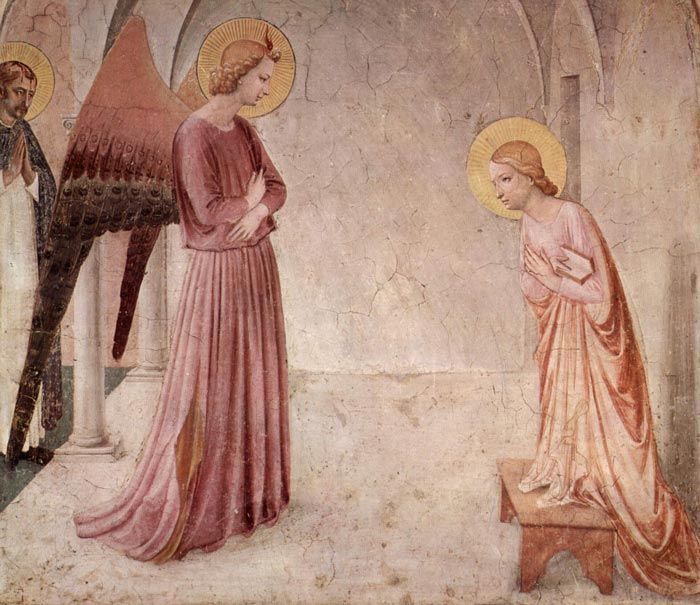 |
Fra Angelico, The Annunciation, late 1430's, Convento di San Marco, Florence
|
This fresco is situated on the wall of the southern corridor, on the upper floor in front of the staircase.
The inscription on the pavement reads 'Salve, Mater pietatis / et totius Trinitatis / nobile triclinium / Maria.
The architecture reflects Michelozzo's designs. |
|
|
|
|
|
In 1448, according to an early chronicle, Fra Angelico received from Piero de' Medici, Cosimo's son, the prestigious assignment to decorate the doors of a silver treasury for the new oratory to be constructed near the chapel of the Santissima Annunziata in the
church of the same name. Fra Angelico did not begin work on this extensive series of small paintings until after his return from Rome in 14491 so. The silver treasury panels were the last major commission undertaken by Fra Angelico and he was evidently unable to bring the project to completion before he was called back to Rome, where he died in February 1455.
Although the themes and settings of the scenes are varied, Angelico united the ensemble with consistently scaled figures, architecture and horizons. The Annunciation takes place within a deep, open courtyard framed by twin porticos, inspired by the architecture of the church.
Throughout the cycle, parallel and prophetic texts amplify the resonance of every scene. In the Annunciation, the quotations from the Book of Isaiah and the Gospel of Luke are virtually identical in phrasing, confirming, according to Christian exegesis, that Isaiah's prophecy was fulfilled through the Incarnation and divinely ordered.
Art in Tuscany | Fra Angelico | Paintings for the Armadio degli Argenti (1451-52)
|
|
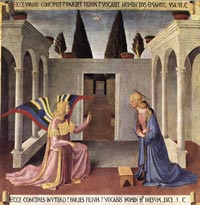 Annunciation, 1451-52, Museo di San Marco, Florence Annunciation, 1451-52, Museo di San Marco, Florence
|

Fra Angelico (c.1400-55)
Fra Angelico was the popular name given to the major painter of the Renaissance in Florence, Fra Giovanni da Fiesole, a Dominican friar. Devoted exclusively to religious art, he employed his art for didactic purposes, and his signature style was simple and direct, though based on the largeness of form of Giotto (1267-1337) and Tommaso Masaccio (1401-1428).
Biography
Fra Angelico's real name was Guido di Pietro, and he was born in the Mugello a decade later than has been traditionally thought. Still a layman in 1417, he is not mentioned as Fra Giovanni until 1423.
The young Angelico was proposed to a Florentine church guild in 1417 by Battista di Biagio Sanguigni, an illuminator of religious songbooks. His familiarity with a miniature-painting milieu probably included Lorenzo Monaco's school in the Camaldolese convent of S.Maria degli Angeli. This would explain the peculiar translucence and brilliance of his tempera style of painting. That Angelico himself worked as a miniaturist is confirmed by Giorgio Vasari in "Lives of the Artists" (1550); his hand has now been detected in at least one missal at S.Marco (c.1428-30) and in a single leaf of the Crucifixion at S.Trinita (1435-40).
By 1418 he was already known for his panel-paintings. His early repertoire - conventional Gothic triptychs with predelle below - represents a synthesis of Sienese-influenced tradition (eg. Lorenzo Monaco), International Gothic intrusion (eg. Gentile da Fabriano), and Florentine innovation (eg. Masaccio). A comparison between his first major surviving altarpiece (c 1424-5; S.Domenico, Fiesole) with the later San Pietro Martire triptych (1429; Museo di San Marco, Florence) shows that Masaccio's influence was decisive.
By the 1430s Fra Angelico had arrived at his own unique style. We recognize it in the Annunciation in the Museo Diocesano, Cortona (c.1432). Here, volume reminiscent of Masaccio has been chastened into something more slender, but no less spacious, as in the proportions of the arcaded loggia which accommodates the Virgin and the vermilion-clad angel before her.
To the same period belongs the Tabernacle commissioned by the Arte dei Linaiuoli, the guild of flax workers (1432; Museo di San Marco). Derived from the Madonna of Humility as evolved by Lorenzo Monaco and the gothic stylist Gentile da Fabriano (1370-1427), the type of the Linaiuoli Madonna was to appear in a whole series of devotional Madonnas of the utmost gentleness which Angelico and his workshop produced during the 1430S. Variants occur in the two polyptychs painted for Cortona (1435-6) and Perugia (1437), and in the central panel of a dismantled polyptych now in the Uffizi Gallery, Florence (c.1440).
Aided by an increasingly productive workshop, Angelico, during these years, was working in the secluded Dominican Observant house at S.Domenico in Fiesole. He was, despite growing fame in the outside world, preeminently a convent painter - according to Giorgio Vasari "most gentle and temperate, living chastely and removed from the cares of the world" - and it is this "medieval" reclusion which has led to him being considered as somehow reactionary. On the contrary: the works Angelico produced during the later 1430S were fundamentally innovative in composition, colour painting harmony, perspective, portraiture, and landscape. Progress in all these directions gained momentum in the decade following the removal of the Dominican Observants from Fiesole to the former Silvestrine convent of S.Marco in Florence (1436). Cosimo de' Medici, who instigated its reconstruction, commissioned Angelico to paint a major new altarpiece for the church's high altar (1438). The central panel (Museo di San Marco, Florence) - an enthroned Madonna, encircled by a meditative entourage of angels and saints - is full of novel features: the prototype of the typically Renaissance sacra conversazione.
The panel is much damaged, and to form an impression of Angelico's tempera style at its most brilliant we must consider the Deposition he painted for the Strozzi Chapel in S.Trinita (1442-5; Museo di San Marco, Florence). Originally commissioned by Lorenzo Monaco (who completed the three pinnacles on top), the limitations of the panel's tripartite shape have been resolved by Angelico's unified figural composition. Unlike the almost contemporary Deposition by Rogier van der Weyden in the Prado, Madrid, Angelico's version has been given a spatial setting of unparalleled depth. It is as if a door has been flung open on the confined schemata of Florentine panel-painting and we have emerged into the real world. Its flowers are before us. And as we advance into the picture space, a majestic panorama unfolds before us: Jerusalem on one side, dominated by its ziggurat-like Temple of Solomon, and on the other, the hills of Tuscany receding, with the most fastidious gradations of light, into haziness. Angelico shows equal lucidity in his variation of colour: delicate mutations preponderantly of pink, vermilion, lilac, and blue reinforce the spatial construction.
It is above all for his fresco paintings in San Marco (the majority completed 1440-5) that Fra Angelico is remembered. They fall into two groups: those for communal contemplation (of which the Annunciation, at the top of the stairs leading to the upper corridor, is again set in an arcaded loggia), and those for private meditation in the individual cells (among these the Noli Me Tangere, the Coronation of the Virgin, and the Transfiguration are especially beautiful).
At the call of Pope Eugenius IV, Angelico left Florence for Rome (c.1445), where, in the Vatican Palace, he decorated the Cappella del Sacramento with scenes from the Life of Christ. These were destroyed by Paul III in the following century.
On the death of Eugenius IV, Pope Nicholas V commissioned Fra Angelico to decorate his own small private chapel in the Vatican. It survives intact (1447-48). Angelico's frescoes - richer in style than those in S.Marco - form an ensemble. Narrative scenes in magnificent architectural settings, from the lives of St Stephen (upper lunettes) and St Lawrence (lower rectangles), are flanked by eight full-length Doctors of the Church (on the lateral pilasters). On the ceiling are the Four Evangelists; the embrasures of the two windows are decorated with alternating prophet heads and rosettes; the lower wall surfaces are painted with a green textile design. Documents show that Angelico did not produce this alone: in May 1447 his workshop included Benozzo Gozzoli and four other assistants. But the speed at which he worked, despite studio assistance, is remarkable. In the summer of 1447 he painted frescoes on part of the ceiling of the Capella di S.Brizio in Orvieto Cathedral. In 1449 he began, and apparently completed, the decoration of the study of Pope Nicholas V (now lost).
Fra Angelico left Rome at the end of 1449. In the following year he succeeded his brother as Prior of S.Domenico in Fiesole. After serving his term, he returned to Rome, where he died in February 1455. He is buried in the Dominican Church of S. Maria sopra Minerva.
It was Giorgio Vasari (1511-74) who popularized the nickname "Angelico" in his "Lives of the Artists" (1550), saying it was the name by which the painter was always known. Another nickname used was "Beato Angelico", meaning the "blessed Angelico", and indeed he was beatified by the Vatican in 1984.

Giorgio Vasari | Lives of the Most Eminent Painters Sculptors and Architects, Fra Angelico | Detailed biography of the artist

|
|
|
| |
|
Fra Angelico in Palazzo Strozzi en Museo San Marco
Beato Angelico a Palazzo Strozzi e Museo di San Marco
26
September - 25 Januari 2026
The exhibition Beato Angelico at Palazzo Strozzi and the Museo San Marco explores the work, development, and influence of Beato Angelico's art, as well as his relationships with painters such as Lorenzo Monaco, Masaccio, Filippo Lippi, and sculptors like Lorenzo Ghiberti, Michelozzo, and Luca della Robbia.
It is the first major exhibition in Florence dedicated to the artist exactly seventy years after the 1955 monograph.
|
![Beato Angelico, veduta della mostra, sala 6, Bernardo Rossellino, Pala di Mariotto d’Angelo (1434) e L'Annunciazione di San Giovanni Valdarno, 1432, Beato Angelico, Palazzo Strozzi, Firenze, 2025 [Photo: Ela Bialkowska, OKNO Studio]](https://lh3.googleusercontent.com/pw/AP1GczPOxrhrmG6-w6YJtMt2rd9WznFhGw6ol2D748Mk48M7O9C_83WmVNB7l7dvVVFXQEjDUorLL41ieeU5jD5cSeQi34NR0pl_NiJzZ-YQNVTuEEjBCfuM=w2400-h1600-p-k)
|
Beato Angelico, veduta della mostra, sala 6, Bernardo Rossellino, Pala di Mariotto d’Angelo (1434) e L'Annunciazione di San Giovanni Valdarno, 1432, Beato Angelico, Palazzo Strozzi, Firenze, 2025 [Photo: Ela Bialkowska, OKNO Studio]
|
 |
|
 |
|
 |
Palazzo Strozzi, Firenze
|
|
Beato Angelico, mostra Palazzo Strozzi and Museo di San Marco, Firenze, 2025
|
|
Museo di San Marco, veduta posteriore
|
 |
|
 |
|
![Beato Angelico, panoramica della mostra con la Pala d'altare di San Marco ( 1438-1442) e la Pala di Annalena (1445 circa), Palazzo Strozzi, Firenze, 2025 [Photo: Ela Bialkowska, OKNO Studio]](https://lh3.googleusercontent.com/pw/AP1GczNBKAgi43MEhBHit3vK00YmiyRsTYQyXCemfRlLigP3CbVRrtBKkgplBTE7YAe4t75NoduxM-cz6UJYpKkyI_au_xMMOAZCkya_mWyNo7UG0rmBYveg=w2400-h1600-p-k) |
Beato Angelico, la grande mostra a Palazzo Strozzi, Firenze, sala 1
|
|
Beato Angelico, Pala della compagnia di San Francesco in Santa Croce (1428-1429) e Giudizio universale (1425-1428 circa), Museo di San Marco, Firenze
|
|
Beato Angelico, panoramica della mostra con la Pala d'altare di San Marco ( 1438-1442) e la Pala di Annalena (1445 circa), Palazzo Strozzi, Firenze, 2025
|

Tuscany is one of the most popular tourist destinations in the world. Known for its enchanting landscapes, its fantastic and genuine food and beautiful towns as Florence, Pisa, Lucca and Siena. Tuscany is much more! Spas and thermal baths, natural parks and caves, traditional festivals & tastings. Podere Santa Pia, a former cloister with an authentic character, is located in the heart of the Valle d'Ombrone, and one can easily reach some of the most beautiful attractions of Tuscany, such as Montalcino, Pienza, Montepulciano and San Quirico d'Orcia, famous for their artistic heritage, wine, olive oil production and gastronomic traditions. It is the ideal place to pass a very relaxing holiday in contemplation of nature, with the advantage of tasting the most typical dishes of Tuscan cuisine and its best wines. Not far from Cinigiano and clearly visible from Podere Santa Pia, is the famous Castle of Poggio alle Mura, also known as Villa Banfi and home to one of the most popular producers of Brunello di Montalcino D.O.C.G. wine. Set in 7100 hectares of land in the Montalcino area, Castello Banfi il Borgo is one of the most important wine producers in Tuscany. This is the land where the DOC wines Montecucco and Brunello are produced. So, the surrounding countryside is the ideal area for an uncommon wine tour, visiting small farms producing wine and excellent extra virgin olive oil.
If you want to spend an unforgettable holiday at Podere Santa Pia, visit our special offers page or contact us. Experience the friendly welcome, unique interior and rural tranquillity... The large garden, stunning stone fireplace and indoor pizza oven, ancient timber beams, stone flag floors and many more period features contribute to the authentic atmosphere and individual charm that our guests enjoy time and time again.
|
| |
|
|
|
|
 |
|

|
Podere Santa Pia, mystic holiday home in the heart of the Tuscan Maremma
|
|
Casa Vacanze Podere Santa Pia, Castiglioncello Bandini, Toscane
|
|
Colline sotto Podere Santa Pia con ampia vista sulla Maremma Grossetana
|
 |
|
 |
|
 |
Pools in a natural area, a dive into the heart of Tuscany
|
|
A beautiful spring morning by the pool, a natural jewel nestled amidst the verdant Tuscan hill
|
|
The night pool at Podere Santa Pia exudes a hypnotic sense of purity
|
| |
|
|
|
|
| |
|
|
|
|
|
|
